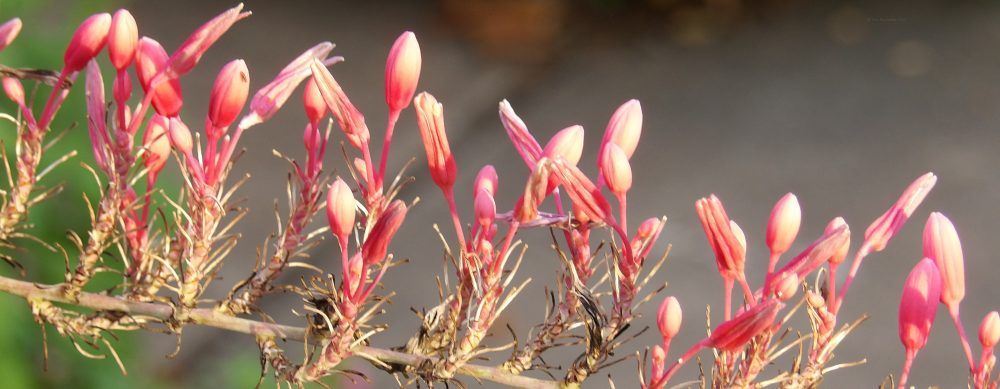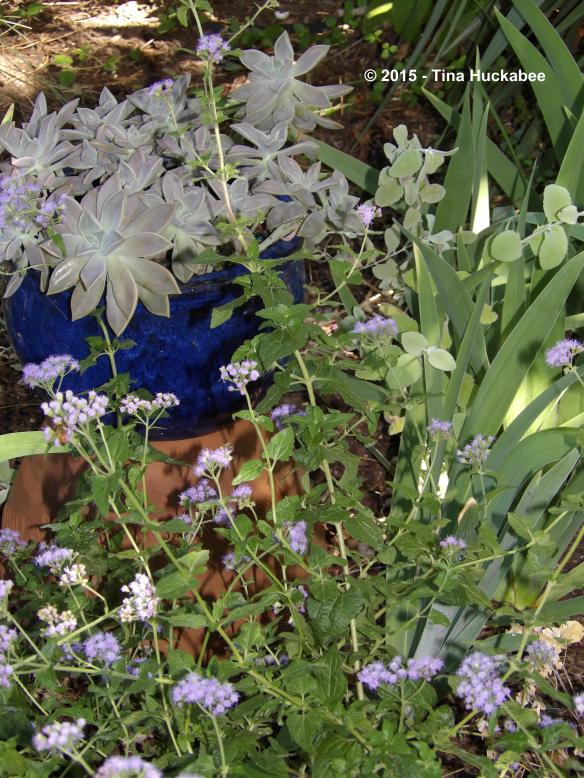The first mistflower plant I ever grew was the Blue Mistflower, Conoclinium coelestinum.
Like Gregg’s Mistflower which I profiled in the most recent A Seasonal Look, this stunning native ground cover is a good autumn perennial to showcase for Texas Native Plant Week. I always think of this mistflower as the blue-headed step-child, especially in comparison to the more commonly grown Gregg’s Mistflower. Blue Mistflower is not as well-known or popular–not one of the cool kid plants, or at least that’s true here in the Austin area. I’m amazed at how few gardeners know about this lovely Texas ground cover.
Just as tough and hardy as its more admired cousin, it’s also a real looker. Pollinator gardening notwithstanding, the Blue Mistflower is my personal favorite. The deep purple-blue flowers,
…in all their puffy pulchritude,
…make me swoon!
I don’t think photos capture the depth of its color. You’ll just have to plant this beauty and see for yourself.
Interestingly, Blue Mistflower has a much wider range of distribution than the Gregg’s Mistflower. I follow several Northern garden bloggers who’ve planted this pretty, though I think it’s probably an annual or tender perennial in some of those places that experience true winter. Its native range is Texas to Florida, but also northward into Illinois and New Jersey (plenty of winter there!) and is grown in other parts of the U.S. as well.
I purchased a four-inch pot of Blue Mistflower for about $1.50 (I don’t remember exactly how much I spent, but it was very little) some 20 years ago. Over time, it filled in a back corner of my garden and put on a reliably gorgeous late summer/fall flower show every year. Eventually, that spot became…something. I never quite figured out the problem, but one spring, only about 10 sprigs returned. So I popped them out of that spot and into a another which receives a tiny bit full sun, but primarily dappled light, throughout the year.
The Blue Mistflower patch has thrived. With an almost identical growth and seasonal pattern as the Gregg’s, the zenith of its blooming occurs during September, October and into November. It is at its peak now.
As the autumn days shorten and cool, the blooms fade from deep blue-purple,
…to soft beige.
After the first hard freeze, the seed heads are wheat-colored and fragile. Like the Gregg’s, I’ve never experienced the Blue Mistflower seeding out, but if you’re so inclined, it’s at this point of the year that the seeds can be sowed.
I tend to leave the winter dormant plant alone until I can’t stand it anymore, then cut it back to not-much-of-anything, except for a light covering of Shumard Oak leaves.
You’ll notice the soaker hose which runs through the middle part of the Blue Mistflower plant. That one hose is generally enough for summer watering, although by hot August and especially if there’s been no precipitation, I sometimes hand water the Blue Mistflower because one hose doesn’t deliver enough moisture to cover all the roots of the entire group. I don’t want the Blue Mistflower to sulk, bloom less, and then cause me to miss out on its gorgeous blooms. I’m not the least bit selfish as a gardener, am I?
With the warmth of spring, the plant returns rapidly. If you look closely at the bottom of the photo, you can see the newly emerged spring growth in March.
Once spring has sprung, the form of the ground cover is firmly established.
While not much of a re-seeder in my garden, Blue Mistflower spreads by the roots. I keep it in bounds by weeding up the edges and passing along sprigs to other gardeners. As with the Gregg’s, I plant smaller evergreens like Iris and Purple Coneflower at the perimeter edges and I also have some container plants placed to visually enforce a stopping point and to give some winter interest. If this Blue Mistflower were planted in full sun, I would have more options for evergreen and structural plants, but this gardener plays the plant cards she’s dealt.
In summer, the foliage is thick and lush.
More than the Gregg’s, which has a comparably controlled growth habit, the Blue Mistflower is a straggler, stems growing wonky and wild over the course of its growing season and that’s especially noticeable once its purple, puffy, floral hats appear.
If you’re a neat-freak gardener you might not like this plant, but I find it casually charming.
Adding to its rangy behavior, Blue Mistflower also puts out stems taller than any of the Gregg’s–upwards of two feet or so.
The leaves of the Blue are triangular-shaped and a darker green shade contrasting with the palmate form and light green foliage of the Gregg’s,
Over the course of summer the foliage continues to grow and the perennial maintains itself as an unexciting, but generally handsome green ground cover, tolerant of heat and summer dry, and sporting the occasional bloom here or there.
In August and in tandem with the Gregg’s Mistflower–the fun begins with fuzzy-wuzzy blooming!!
While Tina the Gardener finds the flowers more alluring than those of the Gregg’s Mistflower, the same cannot be said about most pollinators. The Blue is a good pollinator plant, but not an excellent one, like the Gregg’s.
Monarchs like it just fine.
Honeybees tend to agree.
This Southern Oak Hairstreak, Satyrium favonius favonius, isn’t complaining about Blue Mistflower, either.
But I’ve never witnessed quite the variety of pollinator activity on the Blue Mistflower as on the Gregg’s. If you only have room for one, I’d suggest the Gregg’s, because the pollinators need all the help we can give them and the Gregg’s Mistflower is a Boss Pollinator Plant.
There is a fast flying and hardly landing tiny moth or skipper that I see each fall, flitting around the base of the plant, but it’s been a tough one to capture. I finally snagged a decent photo of one who perched (briefly!) for the camera.
I’ve also seen this one on the Gregg’s too, but it seems to prefer the Blue. I’m glad the Blue Mistflower has a committed pollinating pal.
Even though it’s not quite the power-house pollinator plant that some others are, Blue Mistflower still warms my heart and will always be welcome in my Texas garden!
As a whole and as an addition to a native plants/wildlife garden, Blue Mistflower is a terrific choice for anyone gardening in its range, who seeks a water-wise, attractive, hardy native ground cover that thrives–in both bloom and foliage–in sun or part-shade.
In Spring.
Summer.
Fall.
Winter.



















































All the mist flowers are winners in my book but you’ve got me wondering. The spots I would have to let this one run “free” a bit are all out in proximity to Bambi and Friend’s Diner. Is the Blue Mistflower any less attractive to deer browsing than the Gregg’s? (and if so then hmmm, maybe deer browsing would keep it more compact…?).
LikeLike
You know, I didn’t check about Blue Mistflower deer loveablity, but nothing is mentioned on the LBJWC website. If they do like it, it would be those pretty flowers they eat (probably??) and that would be a drag. It’s not really THAT rangy a plant, but a little wonky–more so than the Gregg’s.
LikeLike
Love this plant! Actually, it’s a hardy perennial here in S. Wisconsin, zone 5a. It’s come back for me after a couple of very cold winters. My biggest problem seems to be keeping the rabbits from eating it, so if I can keep them out with chicken wire and lava rocks, it will probably establish itself in a larger area. I saw so many species of pollinators on it this fall! And you’re right–the blue/lavender shade of the flowers is breathtaking! 🙂
LikeLike
I know you do! You were the main gardener I was thinking about when I mentioned that northerners grow it! I assumed that it wasn’t root hardy as cold as it gets in Wisconsin, but it’s good to know that it’s tough in my heat and your cold.
The mistflowers as a group seem to be such favorites as pollinator plants–always worth having at least one in the garden.
Rabbit stew, anyone??
LikeLike
I’m tempted, Tina. 😉
LikeLiked by 1 person
I have loads of mist flower that grows to over 2 ft tall. It would happily take over my entire garden if it could. It’s a huge thug that I have to rip up by the handfuls just to keep it in check. But I still let it romp through the beds because I love it so much. I have a white form, too. 🙂
LikeLike
Oooo, white- I bet that’s beautiful! I’m not sure mine’s exactly a thug, but it is a bit spready. I wish I had room for more.
LikeLike
it is a pretty little flower and nice ground cover Tina, the one photo that shows it deep, rich blue is beautiful, I find photos often show the colours as washed out, when in real life they are strong and stunning, Frances
LikeLike
It is both, Frances–a great ground cover and lovely bloom. I wish the photos conveyed the true color, but alas…. 🙂
LikeLiked by 1 person
Lovely! Capturing blue on film can be tricky. I haven’t been able to capture what mistflowers look like on film at all. Neither the closeups or the way the blue puddles in fields. I guess I’ll just have to direct people to you! haha
LikeLike
I don’t think most of the photos captured the depth of the color, at all, though a couple are close. It’s a gorgeous color–I just love it!
LikeLike
Pingback: November Blooms | My Gardener Says…
very slow to emerge in wisconsin – usually in june. so, not a good ground cover up here.
LikeLike